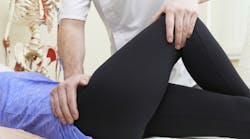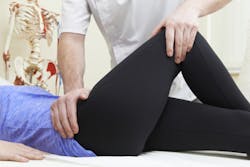Ergonomics: A clinician finds her preventive cure for the 'hygiene hip'
By Jamie Collins, RDH, CDA
If an apple a day keeps the doctor away, what keeps the pain and surgeon away? When I began in the dental field many years ago I never thought it would be as physically demanding as it has proved to be. After years as an assistant and many more as a hygienist, I have felt the little aches and pains that come and go and throughout the years. I finally learned what I wish I knew earlier in my career.
With many dental hygiene schools now focusing on ergonomics and prevention, the newer members of our profession are now learning early on what it has taken many of us years to figure out—prevention. We are in the business of whole body health and with it comes prevention and treatment. We preach prevention to all our patients and how important it is for overall health. But do we all practice what we preach?
Musculoskeletal disorders (MSD) in various forms are widespread among dental workers, and no one is immune to the risks. MSD can range from minor aches and pains to debilitating and career-ending injuries. During my career, I have had the patients who challenge everything I had ever learned about MSD prevention, including the little elderly ladies who holler that it’s “too far” when you have them at a 45-degree angle in the dental chair. You then spend an hour upside down at the most unnatural of angles just to treat the patient. Afterwards, it feels like you’ve been run over.
If poor posture continues or is a common practice, degenerative or irreversible inflammation can occur. With static posture and repetitive motion, the risk of injuries increases. Most commonly, dental workers complain of pain in the upper and lower back, neck, wrist, and hip.
I personally have found that after years of dental hygiene I started noticing pain in my “hygiene hip,” aching and popping often. Like many hygienists I was waiting until the pain and discomfort set in before I would see a chiropractor for a temporary fix. I finally began to realize that I didn’t want to mask the pain and needed to look at other methods to prevent it.
With the everyday craziness of work, family, and other commitments, I have found it easy to make an excuse to not take “me” time. But I now realize how important it is for me and my family. If I am not healthy, then I can’t take care of those around me to the best of my ability, including both family and patients. Making the time and investment in my health and wellness included not only eating better but also includes stretching frequently at home as well as chairside.
Work-related pain is often caused by improper posture, muscle imbalances, unstable core muscles, improper or lack of stretching, and many times not using the proper equipment. Some studies have shown dental workers suffering with some form of work-related MSD range from 64% to 93%. With such a high risk, the importance of prevention should be a priority to ensure and long and healthy career.
Operator chair
Having the right equipment is well worth the investment, even if the employing dentist doesn’t cover the cost. Consider it as an investment in yourself. With constant aches and pain in the hip, I finally got a shiny new saddle stool to replace the older operator chair. I found the noticeable change within days of using it, my hip was no longer hurting after a day’s work and popping much less. The positioning of the pelvis while using the saddle stool made a world of difference for me, even though I had always tried to be aware of my posture while using a traditional operators stool.
Magnification
Another must-have item is magnification while working. When you are able to see the oral cavity easier, your posture is also improved as the clinician is not hunched over. I have used loupes for my entire hygiene career and eventually added a personal light. I now wouldn’t work without either.
Instrumentation
To reduce hand a wrist fatigue, the hygienist should always work with sharp instruments, it also reduces patient discomfort and often working time. Sharp instruments are a win-win for both the hygienist and patient. As a left-handed hygienist, I quickly learned that nothing is made for the lefty in the dental world, and I learned to be creative and adaptive. I would constantly be trying to adapt the handpiece cord under the patients’ headrest, or over the patient is a semi-graceful manner depending on the cord length. I now use a cordless handpiece and found the wrist fatigue to be lessened, no matter the side of chair a hygienist sits on.
I have found the importance of chiropractic visits for not only pain but for preventive maintenance to be helpful. Aligning the body as a preventive and maintenance measure before the pain and discomfort sets in from days, weeks, and months of hunching over patients helps to alleviate the muscle strain. The most enjoyable all around has been getting a frequent massage whenever possible (remember making “me” time). Massages not only help with the muscle tightness but also allows for some downtime to just relax the body and mind.
Daily exercise
In between the chiropractor and massage therapy, there is daily exercise that can and should be done to maintain the balance both chairside and at home. It is easy to develop bad posture habits while working, and a clinician should try to maintain the ideal posture as much as possible to preserve the natural spinal curve.
Taking frequent breaks while working to straighten or roll the shoulder back, lift your head to a natural angle, moving in the opposite way of static posture positioning can help reduce the stress on the body in many ways. I personally will take the natural breaks in treatment to roll my wrists, flex my hands, or roll my shoulders and straighten my back. I find it not only gives my body a break but also allows my patient a mini-break as well.
At home, at the recommendation of the chiropractor I purchased a foam roller for daily use. This little $20 foam roller has saved me from the tightness in the neck and upper back that a career in hygiene can bring. As with any exercise, consult a professional to demonstrate the proper way to use any item. I found a foam roller can work wonders for back, neck and hip tightness.
Not one method works for everyone, and it has taken trial and error for me to find the importance right exercise for my body. Whether your preferences are for yoga, Pilates, or another form of exercise, it is crucial to take time to care for your body to ensure the career you have chosen. An ounce of prevention is really better than a pound of cure.
Jamie Collins, RDH, CDA, resides in Idaho with her husband, Cory, and their four children. She currently works as a full-time hygienist as well as an educator at the College of Western Idaho. In addition, she acts as a content expert and contributor in multiple upcoming textbooks. She can be contacted at [email protected].
References
1. www.mdpi.com/2227-9032/4/1/13/pdf

